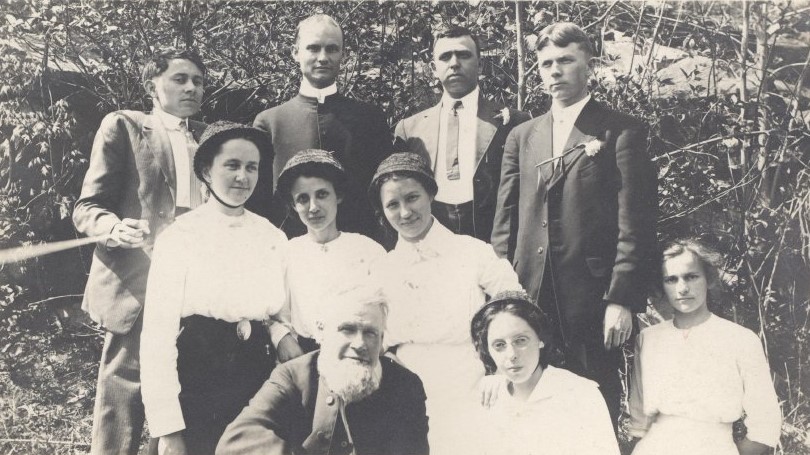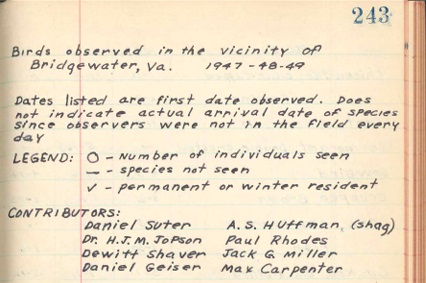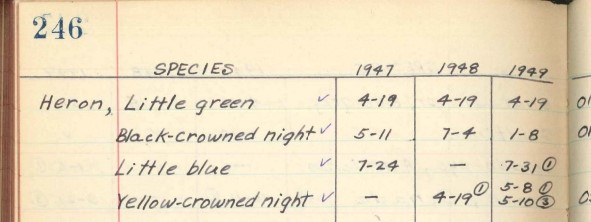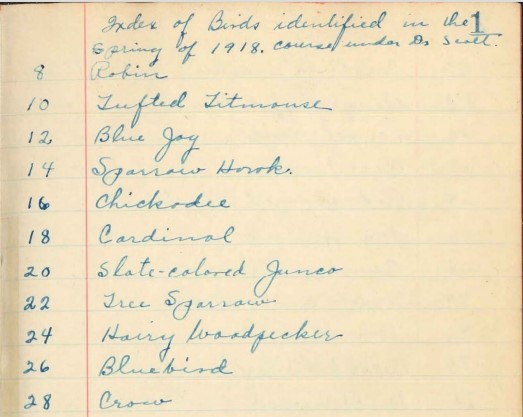From the Robert R. Newlen ’75 & John C. Bradford Special Collections
Archives hold fascinating stories, many forgotten and later retold. This was the case with a simple birding notebook uncovered in Bridgewater’s John Kenny Forrer Learning Commons (FLC). Through this unassuming ledger, mysteries unfolded to reveal connections to people of the past and inspire new discoveries.
I first saw the notebook in 2015 during an inventory of the library’s Special Collections. An earlier BC librarian cataloged the black canvas notebook and wrote “Birds of Bridgewater” in white paint on the spine. The cataloger described the notebook as the 1918 work of Charles S. Driver. The manuscript captured my attention as a birder, since historic birding data is vital for understanding how the ecosystem and species’ behavior change over time. I took care to rehouse the notebook for better preservation and returned to its shelf.
In 2017, a donation to Special Collections brought the notebook back to my attention. David I. McCaskey of Staunton, Va., gave the papers of his late father Andrew L. McCaskey Sr., a regional writer, broadcaster, birder and historian, to the library. McCaskey also mentioned that his grand-uncle Charles S. Driver was a naturalist and a 1916 Bridgewater College graduate. I remembered the name from the birding notebook and decided to see what else I could learn about the man and the notebook.
Charles S. Driver was born in 1891 and grew up on his family’s farm near Weyers Cave, Va. A childhood injury left him with an unusual posture and required ongoing boyhood medical care. He was a member of the Church of the Brethren, an avid naturalist and an experienced photographer. Driver graduated from BC’s Bridgewater Academy in 1912 and continued his studies to earn a college degree. His classmates and family remembered Driver as social and active. Though his injury may have left him physically disabled, Driver appears to have lived Bridgewater College life to the fullest. Among the archival photographs in Special Collections are images of him in a tennis class, serving in a campus journalism organization and in group portraits with his classmates, along with several photographs that he made while hiking with Bridgewater groups. In some images Driver is shown pulling a cord to take these outdoor images, making these photographs early 20th-century selfies.

After completing his BC degree in 1916, Driver did postgraduate work in marine biology at Columbia University and Indiana University, where he worked as a graduate assistant. While in Indiana, he studied birds at West Lake, located about 50 miles north of the university. In the spring of 1918, Driver made note in the black canvas notebook of approximately 116 species of birds, including the dates seen, dates the species became common, field marks and nesting habits. The following spring, he added more birds to the list. These notes filled the first pages of the black canvas notebook that I discovered in Special Collections nearly 100 years later. But I wondered how the notebook ended up at Bridgewater College.
It turned out that in the summer of 1920, a 28-year-old Driver was offered a position as Chair of the Department of Biology at Bridgewater. This was surely a major achievement for this young scholar. But his story took an unfortunate turn. While rowing at the seashore near Woods Hole, Ma., a canoe carrying Driver and three other young people capsized. The others were rescued but Driver drowned. He now rests in the Pleasant Valley Church of the Brethren cemetery in Weyers Cave, Va.
The birding notebook apparently sat unused for years after Driver’s death. But by the mid-1940s it had made its way to Bridgewater, where a group of men somehow acquired the notebook and began recording data on local birds. This time it really was “Birds of Bridgewater.” They recorded regional birds from 1947-1949.
The new additions brought other recognizable individuals into association with the old birding notebook. Among those who contributed birding observations in the 1940s was Harry G.M. “Doc” Jopson, a popular biology professor and track coach at Bridgewater College from 1936 to 1981. In addition to his teaching, Jopson conducted research and taught for many years at the Mountain Lake Research Center near Blacksburg, Va., and later discovered a new species of salamander.

Another contributor to the birding notebook was coach Daniel S. Geiser, best known for restarting the Bridgewater College football program on a shoestring budget after World War II. Geiser also began health and physical education as a major course of study at the College in 1951. Like several other contributors to the journal, Geiser was a World War II veteran.
In August 1949, the birding group’s secretary, Max Carpenter, signed the second part of the notebook with a total of 195 recorded species. Carpenter, a member of BC’s class of 1950, went on to become a wildlife biologist for the Virginia Department of Game and Inland Fisheries. He and Jopson contributed to the study of birds of the area throughout the rest of their lives.
Many of the birds that they recorded in the archived notebook are seen in our area today. Some, like a red-headed woodpecker and a peregrine falcon, were seen in only one of the three years recorded in the journal. Others, like a loggerhead shrike and a scarlet tanager, were spotted all three years. Like Driver before them, the 1940s group made some notable later additions to the notebook. These included a golden plover spotted in October 1949 and a snowy owl in December 1949.
An especially exciting find was a yellow-crowned night heron spotted on April 19, 1948. So rare was this sighting that Carpenter’s account of it was published in the January-March 1949 issue of the prestigious ornithology magazine The Auk. Carpenter wrote that he saw the bird on the North River near Bridgewater. He tried to find the heron again the next day but was unsuccessful. Then, two days later, he flushed out the heron, “collected” her and sent her skin to a scientific bird skin collection. Additional yellow-crowned night herons were recorded the following spring.

A third part of the notebook lists birds seen on a May 6, 1950, field trip with the Virginia Ornithological Society. Sixty-five unnamed people visited Silver Lake, Mossy Creek and Hone Quarry Hollow in Rockingham County, Va. There is a simple list of the 108 species of birds seen that day.
The old birding journal took on new life yet again in November 2023. On an autumn day when the air was getting thick with the smoke of regional wildfires, intern Mackenzie Smith ’24 and I went birding by the North River adjacent to Bridgewater College, adding our sightings to the journal. We didn’t write in the historic notebook but inserted a leaf with our findings, becoming the first named women to contribute to the journal. Much has changed since Charles Driver started the journal in 1918. We were aided by technology that allowed us to better see the birds and identify them by their calls. We identified 25 species of birds on and near the Bridgewater College campus that morning.
Today the birding ledger is preserved in the FLC’s Robert R. Newlen ‘75 and John C. Bradford Special Collections. Like all Special Collections materials, it is available to view by appointment. A digital copy is available to download in the College’s Digital Commons.
– Stephanie S. Gardner
Special Collections Librarian


